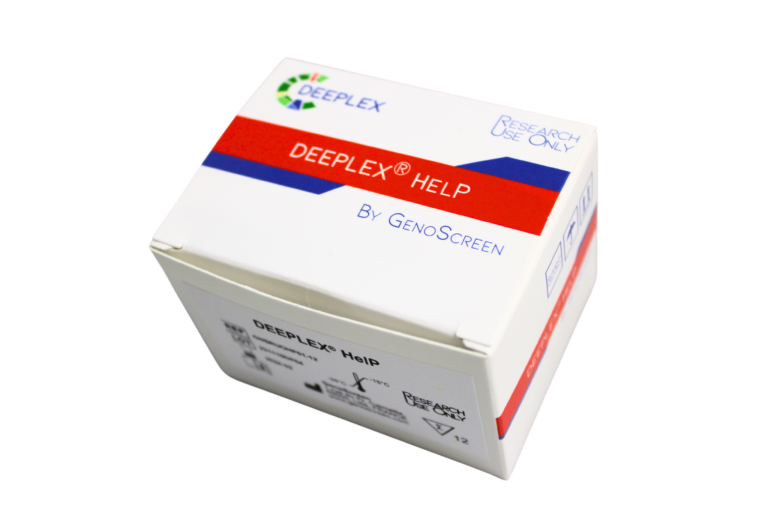Deeplex® HelP
Advanced Diagnostic Test
for Helicobacter pylori (H. pylori)
Infections and Antibiotic Resistance
Powered by GenoScreen
Be among the first to experience our next-generation H. pylori resistance testing kit. Join as an early user today.

Deeplex HelP: H. pylori resistance diagnostic solution
6
antibiotics
screened*
7
genes for strain typing
2
genes for virulence prediction
48h
from clinical samples to results
*Clarithromycin, levofloxacin, rifampicin, tetracycline + exploratory variant detection in genes associated with metronidazole, amoxicillin resistance.
Key components of
Deeplex HelP
- Deeplex Master Mix: a single PCR mix for amplifying H. pylori gene regions involved in antibiotic resistance, strain typing, and virulence factor genotyping.
- Internal control for in-sample quality control.
- Positive control for test validation.
- Automated analysis via GenoScreen proprietary automated bioinformatics pipeline for fast and secure data interpretation.
Download the technical note
H. pylori and antibiotic resistance: a global threat
H. pylori infection is a major global health concern, associated with gastritis, peptic ulcers, and gastric cancer. This bacterium affects approximately 50% of the world’s population, with prevalence varying by geographic region. The risk of developing H. pylori-related diseases depends on multiple factors, but global health authorities estimate that 660 million people (15%) will develop peptic ulcers, and 66 million (1.5%) will develop stomach cancer.
Antibiotic resistance is a major cause of H. pylori treatment failure. The World Health Organization has highlighted H. pylori as a priority antibiotic-resistant pathogen, underscoring the need for improved diagnostic and treatment strategies. Clinical guidelines recommend tailoring therapy based on local antibiotic resistance prevalence. However, such data may be limited or outdated in many settings.
Deeplex HelP enables direct genotypic resistance profiling from patient samples, supporting a more personalized approach to H. pylori treatment.
How Deeplex HelP makes a difference
Deeplex HelP is a cutting-edge molecular assay designed to predict H. pylori antibiotic resistance. By combining strain typing, genotyping of virulence factors, and resistance prediction in a single test, Deeplex HelP empowers clinicians to make faster, more targeted treatment decisions – improving outcomes and supporting efforts to combat targeted antimicrobial resistance.
Key benefits of Deeplex HelP
- Comprehensive insights into H. pylori strain type, virulence markers, and predicted resistance to key antibiotics
- Culture-free workflow – no need for bacterial culture or lengthy laboratory procedures
- Streamlined, single assay enabling personalized, resistance-guided therapy
- Supports more effective treatment strategies, with the potential to improve eradication rates and reduce complications such as gastric ulcers and gastric cancer
Prevent gastric inflammation and ulcers
The pathogenicity and treatability of H. pylori depend on a complex interplay of factors, particularly bacterial strain identity, virulence, and antibiotic resistance. Current diagnostic methods – including PCR, LPA, and culture – are either limited in scope or impractical due to their complexity, slow turnaround, and inability to detect all clinically relevant resistance and virulence markers.
Deeplex HelP is a culture-free, targeted deep sequencing assay that simultaneously provides strain typing, virulence profiling, and antibiotic resistance prediction. This comprehensive approach enables clinicians to guide therapy more effectively, reducing the risk of treatment failure and long-term complications such as gastric cancer.


Indications and applications
Deeplex HelP supports a wide range of clinical and research settings where accurate H. pylori resistance insights are essential:
- Gastroenterology clinics – guide treatment decisions in patients with H. pylori-related conditions
- Clinical microbiology laboratories – implement a rapid, culture-free approach to antibiotic resistance prediction
- Infectious disease units – apply targeted therapies and strengthen antimicrobial stewardship
- Public health surveillance programs – track resistance trends and inform population-level interventions
- Pharmaceutical and clinical research teams – evaluate treatment efficacy and investigate H. pylori resistance mechanisms
Questions & Answers
Why does H. pylori matter globally?
H. pylori infects nearly half the world’s population, making it one of the most common bacterial infections.
While often silent, it’s a leading cause of peptic ulcers and is linked to serious diseases like gastric cancer and MALT lymphoma.
Recognized as a Group 1 carcinogen by the International Agency for Research on Cancer, H. pylori is the top cause of infection-related cancers – responsible for over 750,000 new cases in 2018 alone.
Why are H. pylori treatments failing more often today?
Eradicating H. pylori can prevent serious diseases, including gastric cancer – but treatment isn’t as effective as it used to be.
One major reason is antibiotic resistance. Over the past two decades, resistance to key drugs like clarithromycin and metronidazole has surged, with failure rates rising accordingly. In Europe, up to 30% of patients are now resistant to common first-line antibiotics, even if they’ve never been treated before.
This growing resistance makes it harder to rely on a one-size-fits-all treatment – and underscores the need for more personalized approaches.
Is resistance testing possible before treatment begins?
Yes – but current methods have limitations.
Culture-based testing is the gold standard, but it’s slow, technically demanding, and not commonly available.
Molecular methods are faster and more widely used, but typically focus on detecting H. pylori and resistance to a single antibiotic – usually clarithromycin. Even then, they often analyze only a limited set of mutations, which may miss emerging or less common variants.
As a result, many patients are still treated empirically – without knowing whether the treatment will actually work.
What makes Deeplex HelP different?
Deeplex HelP goes beyond conventional diagnostics. It uses targeted next-generation sequencing (NGS) to provide a full resistance profile directly from gastric biopsy samples – no need for culture.
It detects resistance to multiple antibiotics, including clarithromycin, levofloxacin, tetracycline, and rifampicin, with additional insights into metronidazole and amoxicillin.
The test also captures virulence factors and strain information, giving a comprehensive picture in a single assay.
Is Deeplex HelP fast enough for clinical decision-making?
Absolutely. Deeplex HelP is designed for in-house use and delivers results within 48 hours from sample to report.
The streamlined process – combining a single-tube multiplex PCR with automated analysis – makes it both time-efficient and lab-friendly.
Results are delivered in an interactive, easy-to-read report that supports rapid, informed treatment decisions.
Can Deeplex HelP support public health and surveillance efforts?
Yes.
In addition to guiding individual treatment, Deeplex HelP provides valuable data for epidemiological tracking and antimicrobial resistance monitoring. It identifies H. pylori strain types and virulence markers – supporting both clinical care and population-level strategies.
